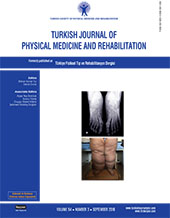Relationship between core stability and dynamic balance in women with postmenopausal osteoporosis
2 Department of Physical Medicine and Rehabilitation, Ankara Numune Training and Research Hospital, Ankara, Turkey
3 Department of Radiology, Ankara Numune Training and Research Hospital, Ankara, Turkey DOI : 10.5606/tftrd.2018.1674 Objectives: The aim of this study was to investigate the relationship between core stability and dynamic balance in women with postmenopausal osteoporosis.
Patients and methods: A total of 100 females (mean age 59.9±7.5 years; range, 42 to 73 years) with postmenopausal osteoporosis between January 2016 and June 2016 were included in this study. All patients were evaluated for dynamic balance with the Star Excursion Balance Test (SEBT) and for core stability with trunk flexion, extension, and Side Bridge Test (SBT).
Results: There was a significant correlation between age and the reach directions of anterior (A), posteromedial (PM), and posterolateral (PL) of the right limb (p<0.001, p=0.009, p=0.012) and the reach directions of A and PM of the left limb (p<0.001, p=0.004). There was no correlation between the lumbar spine, femoral neck, and total hip Bone Mineral Density (BMD) and the reach directions of SEBT (p>0.05). There was a significant correlation between the trunk flexion test results and the reach directions of A, PM, and PL of the right limb (p=0.005, p=0.001, p=0.002), (r=0.277, r=0.333, r=0.308) and the reach directions of A, PM, and PL of the left limb (p=0.008, p=0.016, p=0.005), (r=0.265, r=0.239, r=0.276). There was a significant correlation between the SBT results and the reach directions of A, PM, and PL of the right limb (p<0.001, p<0.001, p=0.005), (r=0.423, r=0.366, r=0.281) and the reach directions of A, PM, and PL of the left limb (p<0.001, p<0.001, p=0.001), (r=0.418, r=0.356, r=0.316). There was a significant correlation between the trunk extension test results and the reach directions of A, PM, and PL of the right limb (p<0.001, p<0.001, p=0.006), (r=0.383, r=0.471, r=0.276) and the reach directions of A, PM, and PL of the left limb (p<0.001, p<0.001, p=0.003) (r=0.407, r=0.401, r=0.297).
Conclusion: Our study results showed that age and core stability were associated with dynamic balance in women with postmenopausal osteoporosis.
Keywords : Balance; core stability; osteoporosis

















